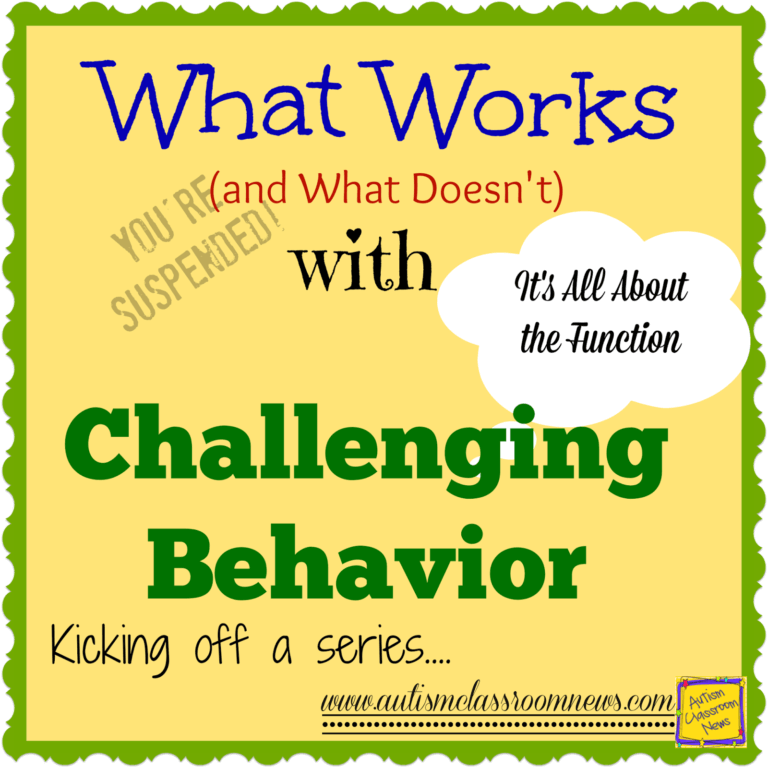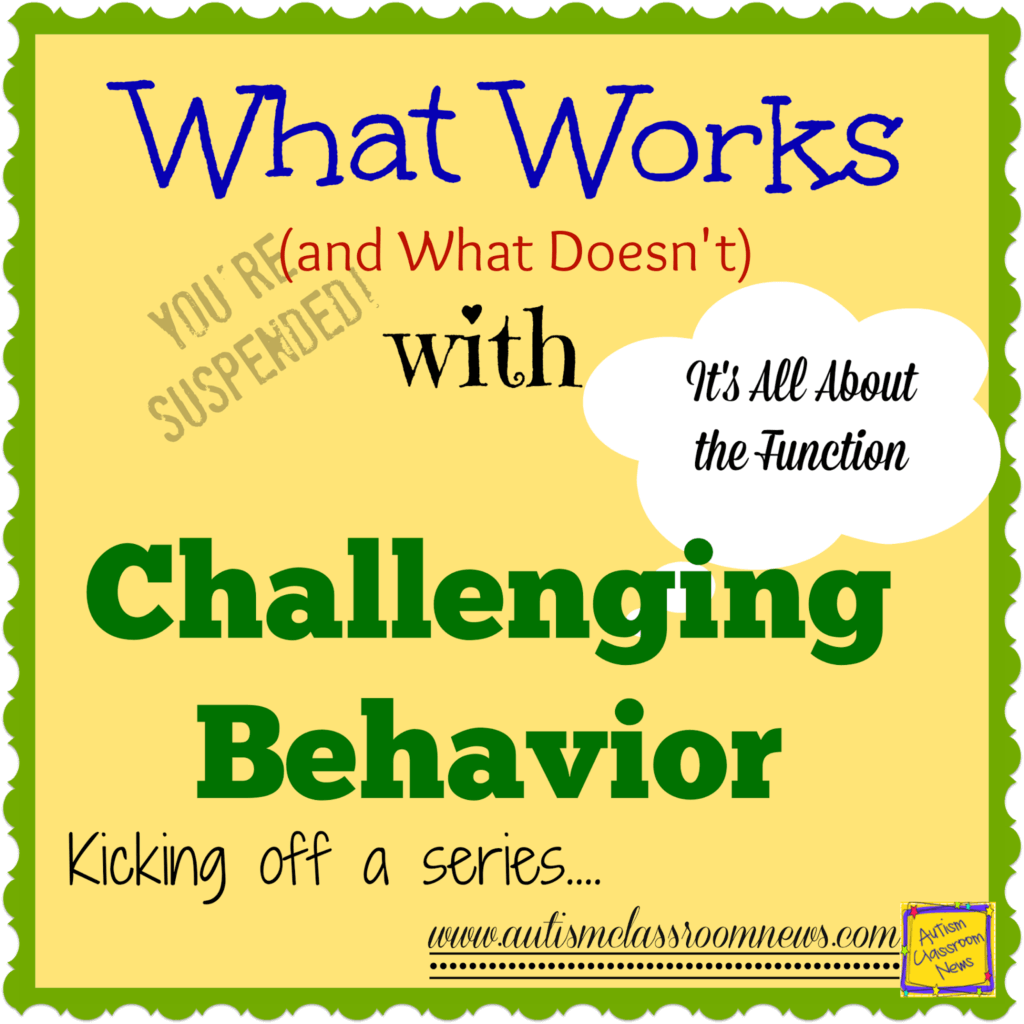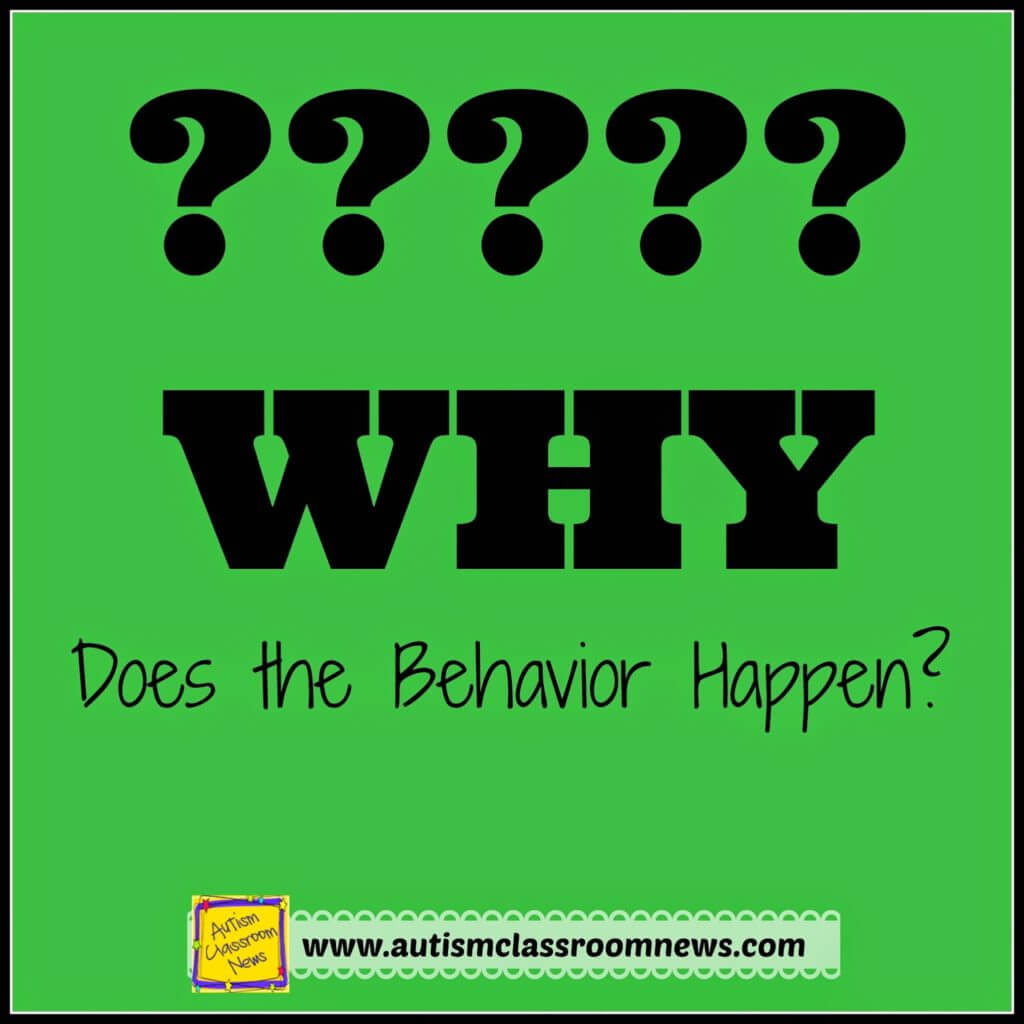Challenging behavior, problem behavior, misbehavior, bad behavior. Whatever we call it, we want to change it. How to do that is always the challenge. What you may not know is that my early research and academic career was in addressing challenging behavior and that continues to be a large focus of my practice, teaching, and training. To paraphrase Top Gun, If I’m not working with a kid “going Mach 5 with my hair on fire,” apparently I don’t feel like I’m doing my job (and yes, I just realized that I dated myself–I’ll do it again later when I tell you how long I’ve been doing this!). So, sit back and get ready because I am starting a series on my favorite topic.
Behavior is challenge for most professionals and many if not most families working with students on the spectrum and other special needs. To kick us off, let’s look at some things that work and some that don’t and then talk a little about the most effective ways to approach challenging behaviors.
Strategies That Don’t Work
Expecting students to behave
Yes we live in an educational world of high expectations and yes we need to challenge our students to perform and that includes behaving appropriately. However, guess what? If the student is displaying behaviors that are maladaptive, inappropriate, dangerous, harmful, or just interfering with his or others’ learning, then the expectation of behavior did not work. Expecting appropriate behavior is no different than expecting a student to do calculus. If we haven’t taught it, he hasn’t learned it, or he has a skill deficit or learning in math, he’s not going to be able to do it.
Suspending the Student
In some instances, where the typical high school student commits a behavior that gets him a 2-day suspension, having him out of school might be a lesson that keeps him from getting into trouble. However, for most of the individuals we are talking about with histories of challenging behavior, suspension might not be an option beyond a certain point. More importantly, though, it probably doesn’t work. In fact, it may increase behavior. If I’d rather be hanging with the guys on the street than hanging out in class, getting suspended works for me. Similarly if the individual has a developmental disability and is struggling in school, suspension might reinforce the behavior (he escapes from a difficult situation) or it may teach him that was the wrong thing to do, but he may not be able to problem solve to know what he should have done instead. Plus, suspension sends the wrong message. It sends the message that you don’t belong in school. If this becomes what a student associates with him/herself, then his behavior will change accordingly.
Sending the Student to the Office
This one has the same issues as suspension. If the student is getting out of a situation he doesn’t know how to handle or manage and/or he’s getting extra attention (even what we perceive to be negative attention) from the office staff and/or administrators, then we may be making the problem worse. Sending students out of the classroom might work for the teacher (it’s reinforcing for the teacher since the problem behavior essentially stops in the classroom), but it’s not a solution for most students.
 |
| No this is not an overnight cure |
Overnight Cures
Oh how I wish these worked. Are there strategies that we can put in place that can improve behaviors in certain situations? Absolutely. One of my favorite that I can’t believe has worked every single time I’ve used it in the last 25 years is putting feet on the floor and challenging behaviors around lining up improve. No every child’s behavior is perfect in that situation, but the dramatic improvement across the class can be significant. However, it doesn’t solve the overall behaviors that have existed all year long, throughout the day. It’s a tool and it works in some situations. It’s a piece of a solution, but not the whole solution. Medication might make an overnight difference to some student. With the students I work with, it’s more likely that it will cause more problems rather than less since many individuals with autism have unusual reactions to medications. And then there are the side effects. Even when medication works–it’s not a cure any more than taking an appetite suppressant might decrease overeating. It might work in the short term, but in the long term, we need to be teaching some appropriate behaviors in the interim.
Tackling the Behavior Alone
This is less an issue for classrooms than families, but as someone who has experienced both, one thing is for sure. If you try to address and manage challenging behaviors on your own, it’s going to be tough. Just as your child or student needs a support system, so do their parents and teachers. Burnout is high for special educators, in large part because of significant challenging behaviors of their students. All of us need support and we need more people to generate more ideas. The more ideas, the more likely we will find one that works. Whether it’s the staff in your classroom or your school if you are a teacher or your extended family and/or neighbors in you are a family member, don’t go it alone. Reach out and ask for help. Family members–ask the educators. Teachers–ask the families. And everyone ask their team members to collaborate because everyone has something to bring to the table, even if it’s just understanding.
What Does Work?
Understanding the Function of the Behavior
Behavior happens for a reason. There, I said it. Argue in the comments. That reason, or function, is NOT to deliberately be a bad kid. Being bad is NOT a function. Functions are why the behavior happens–or in other words, what does the student get out of it? Cause I guarantee there is a payoff–it may be just very hard to find. To be clear, human behavior is one of the most complex entities in the world and we do not understand all of it or why people do the things they do. However, that doesn’t mean there is isn’t a reason that they do them; it just means we don’t know what it is. We will spend considerable time talking about being “undercover detectives” as my friend Abby used to say and trying to figure out the function.
Addressing the Function Instead of the Form
Behavior analysts (myself included) spend a lot of time talking about defining what behavior looks like so we can track it. But you know what? Knowing what it looks like doesn’t really tell us what to do about it. Ask me what to do about biting and I’m going to ask you a lot of questions to try to figure out the function of the biting; because there is no solution for biting. Jim bites to get you to leave him alone. Rose bites to get you to interact with her. And Randi bites because it provides some type of internal reinforcement we can’t see. Three functions, one form. We might teach Jim to ask for a break or ask to be alone. We might teach Rose to call our name or tell a joke. And we might teach Randi to engage in a variety of leisure activities to keep her engaged to prevent the biting.
Working as a Team
One of the most important lessons I have learned in my career is that you can get more done with a well-run team than one person can ever do alone. We have some good research that indicates with behavioral issues, someone with behavioral knowledge (it doesn’t have to be a board certified behavior analyst) writes the behavior plan, you get a solid behavior plan that addresses the underlying function of behavior. However that plan often doesn’t get implemented because it doesn’t have good contextual fit with the individual’s environment. That’s systems-eese for it can’t be implemented in that environment effectively. Similarly, if you have a team consisting only of the people in the student’s environment and you don’t have someone with an understanding of behavior analysis, you get a plan that can be implemented (and is) but isn’t effective because it is probably not based on the function of the behavior. If you have a team that has the expertise and the daily life folks, you develop a plan that has both effective strategies as well as fits into the context of the individual’s daily life. The moral of the story is that there is more than one solution for every problem, and effective teamwork trumps the expert-alone model every time.
So, I think that’s enough to get us started. There are more things that don’t work than do in my list, but that’s because the “do work” things are what I will be talking about in the next few weeks. Because it’s great to tell you something does or doesn’t work, but if you can’t put it into place, it doesn’t matter.
Until next time,










